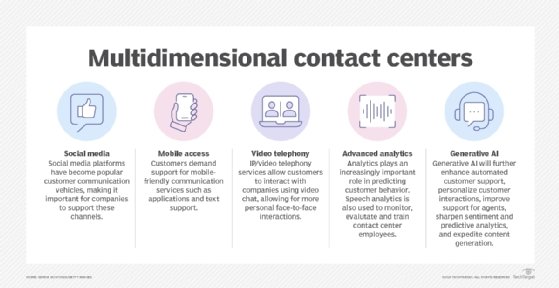contact center
What is a contact center?
A contact center is a central point from which organizations manage all customer interactions across various channels. Their primary purpose is to offer customers efficient and effective technical support, customer service and sales assistance.
Contact centers typically include one or more call centers but may also include other types of customer contact channels, including emails, webchats and social media interactions. Also, organizations often integrate contact centers with their customer relationship management (CRM) strategies.
Contact centers are growing in importance, as customers increasingly expect organizations to be consistently available on various channels, not just over the phone. Contact centers take an omnichannel approach, enabling them to refine customer service, increase efficiency and improve insights into customers' behaviors and needs to create better customer experiences.
How do contact centers work?
Typically, contact centers include agents who handle omnichannel customer support, including calls, email, chat, voice over IP (VoIP) and website support. Contact centers are similar to call centers yet go beyond simply handling calls to reach customers on their preferred channels.
Key features of a contact center include the following:
- Automatic call distributor (ACD) systems, which enable contact center agents to increase the number of calls taken while maintaining a positive customer experience (CX);
- Real-time reports, which enable contact centers to observe and analyze agent performance and customer satisfaction in real time across the various channels used;
- Scripts, which give agents a framework to provide callers with effective support and to generate sales; and
- Interchangeable assignments, which means agents who share contacts and objects can work together while maintaining individual stations.
Contact center vs. call center: What are the differences?
Contact centers and call centers are both centers for customer service. Many people use the two terms interchangeably, although they shouldn't. The primary difference is that call centers only manage inbound or outbound calls, while a contact center offers omnichannel customer support.
The contact center's modular infrastructure also allows managers to enhance the team's efficiency and allows teams to benefit from better security measures, more secure data and increased flexibility.
While contact centers serve various functions, call centers specifically manage phone interactions, including inbound and outbound calls. Like contact centers, call centers generally support customer service, technical support or sales interactions. However, organizations can also use them for telemarketing, information gathering, debt or payment collection and fraud prevention.
What are the benefits of a contact center?
Contact centers provide several advantages over call centers.
Saves time and money. Contact centers allow customers to self-serve and solve their problems with two-way, keyword-driven instant messaging, text messaging or communication with a chatbot. This self-service decreases the amount of time agents spend on the phone, reducing customers' wait times and lowering overall costs.
Better customer information. Contact centers can enhance customer profiling. When customers interact with call or contact centers, they share information about their personal preferences and behavior, which agents can gather and use to improve CX in future interactions. Organizations can also integrate CRM software with contact centers to collect more customer data and analyze it efficiently.
Improve CX. Call center agents can collect data through their calls, but the digital channels that contact centers use make the process easier and more effective. Contact center software gathers customer data from every channel used and compiles it into a single customer profile. Because most contact center customers interact using multiple channels, the center collects more data. More data can enable the contact center to tailor CX to benefit specific callers and better route calls and other communications.
Better use of interactive voice response systems. Call centers use IVR as an automated digital assistant that operates over the phone through vocal prompts and keypad entries. IVR in call centers often makes it difficult to reach a live agent and solve problems efficiently. However, contact centers create IVR with CX in mind. Contact center managers design IVR to predict caller intent and direct callers to the best-suited agent. Other times, IVR can solve customer queries and problems without involving live agents.
Types of contact centers and use cases
The different types of contact centers are hardware, cloud-based, hosted and virtual.
Hardware contact centers. Organizations can install and host hardware contact centers on physical, on-premises servers. Consequently, hardware contact centers require organizations to have sufficient space and capacity to house and maintain the servers, effective disaster recovery procedures and competent hardware update processes.
Cloud-based contact centers. Cloud providers' internet servers host these contact centers, which filter all inbound and outbound communications. Contact center agents can access cloud-based contact centers anywhere on the internet. These contact centers function the same as others.
Hosted contact centers. For these contact centers, the organization outsources the infrastructure to another company that manages the systems externally. This approach can minimize costs and maintenance upfront, which often leads to a better ROI.
Virtual contact centers. These contact centers enable agents to work remotely. Virtual contact centers create flexibility and comfort for contact center agents while simultaneously lowering costs for the organization.
Contact center capabilities and infrastructure
Organizations often build contact center infrastructure to support communications on the same premises as the contact center -- as with hardware centers. Or, organizations can outsource the infrastructure for the three other types, and other companies host it externally.
In an on-premises scenario, the organization also owns and manages its hardware and software. This approach requires staffing and IT investments that some organizations outsource to cloud providers or hosting companies.
Operations research and analysis and mathematical models, such as queuing theory, can support contact center performance. However, contact centers support multiple channels, so they do not have to support universal queuing. They may instead use separate systems with varying business processes.
Contact center technologies
Technologies used to maintain and improve contact center performance include the following:
- ACD system: Analyzes incoming calls and distributes them based on varying factors, such as the number called.
- Email response management system: Collects and analyzes customer inquiries submitted over email and then routes those inquiries to the appropriate agent.
- IVR system: Enables customers to use a keypad or voice commands to provide information without human assistance.
- Knowledge management system: A central repository of information that agents can easily search, which can cut down on agent training time.
- TTY/TDD communications: Teletypewriters (TTY) and telecommunications display devices (TDD) offer assistance for deaf or hard-of-hearing individuals.
- Workforce management system: Helps schedule and staff agents and manage their performance.
Contact center systems often use call center software. For example, virtual contact centers may use virtual call center software to create a channel for remote agents to manage phone calls as if they were in a centralized call center. However, contact center software often builds upon these basic abilities to further integrate services across various channels and enable agents to route contact information, track contacts and gather data.
Popular contact center software vendors include Five9, Avaya, 8x8, Twilio, Talkdesk and Genesys.
The future of contact centers
As technology evolves and customers rely on newer communication channels, contact centers must continue to adapt and grow. Trends affecting contact center communications include the following:
- Social media. Social media platforms, such as Twitter, have become popular customer communication platforms, making it important for organizations to support these channels.
- Mobile access. Customers demand support for mobile friendly communication services, such as application and text support.
- Videotelephony. IP/video telephony services, such as FaceTime and Zoom, enable customers to interact with organizations using video chat, enabling more personal, face-to-face interactions.
- Advanced analytics. Analytics play an increasingly important role in predicting customer behavior. Organizations may also use speech analytics to monitor, evaluate and train contact center employees.

Experts expect AI and augmented reality (AR) technology to take on prominent roles within contact centers. Currently, AI development focuses on agent-assist tools that can listen in on calls and follow agent prompts to crawl customer service records and suggest answers to customers' problems during a live conversation. AR introduces a visual element to live agent and customer interactions, so agents could suggest and show solutions to technical problems that verbal descriptions over the phone or chat can't replicate.







